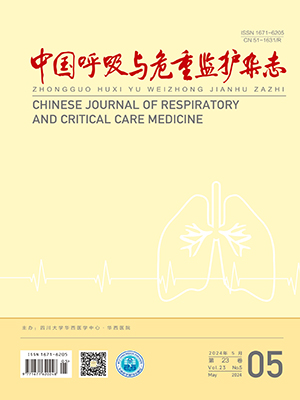Objective To determine the airway wall thickness at the segmental and subsegmental levels in patients with bronchial asthma and eosinophilic bronchitis ( EB) by high resolution CT scanning,and evaluate its relationship with airway hyperresponsiveness. Methods High resolution CT scanning was performed in 14 subjects with asthma,15 subjects with EB, 15 subjects with cough variant asthma ( CVA) ,and 14 healthy volunteers. Total airway and lumen diameter, total airway cross sectional area and lumen area which corrected by body surface area ( BSA) were measured. The percentage of airway wall area to total airway cross sectional area ( WA% ) and wall thickness to airway diameter ratio ( T/D) were calculated for the right upper lobe apical segmental bronchus ( RB1) and all airways clearly visualized with a transverse diameter of 1-6 mm. Results T/D/BSA and WA% in the asthma patients were all significantly higher than those in the subjects with EB, CVA and healthy volunteers. T/D/BSA and WA% in the EB patients were significantly higher than the healthy volunteers, and similar with the CVA patients. Al /BSA in the patients
with asthma and CVA was less than the subjects with EB and the healthy volunteers. However, Al /BSA in the EB patients was similar with the healthy volunteers. Conclusions The airway wall thickness and remodeling can be measured and assessed by high resolution CT. Airway wall thickness and remodeling in
EB patients are milder than asthma patients, which may be associated with airway hyperresponsiveness that presents in asthma but not in EB.
Citation: WANG Jiaoli,REN Zhenyi,YANG Bin,HUANG Sheng,WANG Limin,YE Jian,XIA Junbo.. High Resolution Computed Tomographic Assessment of Airway Wall Thickness in Patients with Bronchial Asthma and Eosinophilic Bronchitis. Chinese Journal of Respiratory and Critical Care Medicine, 2011, 10(2): 126-129. doi: Copy




